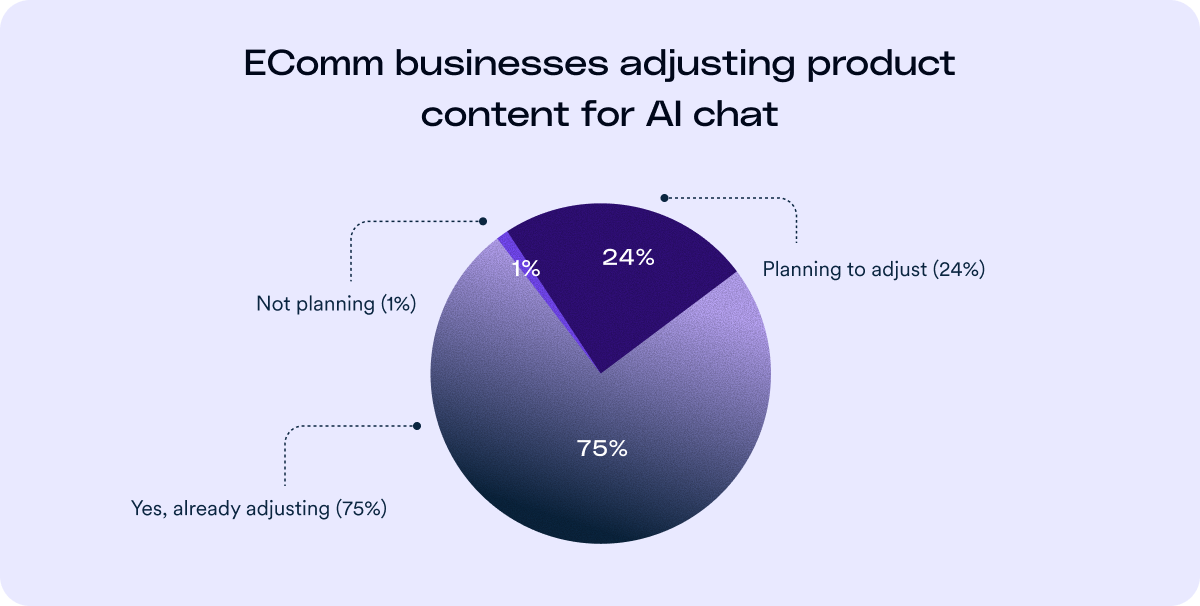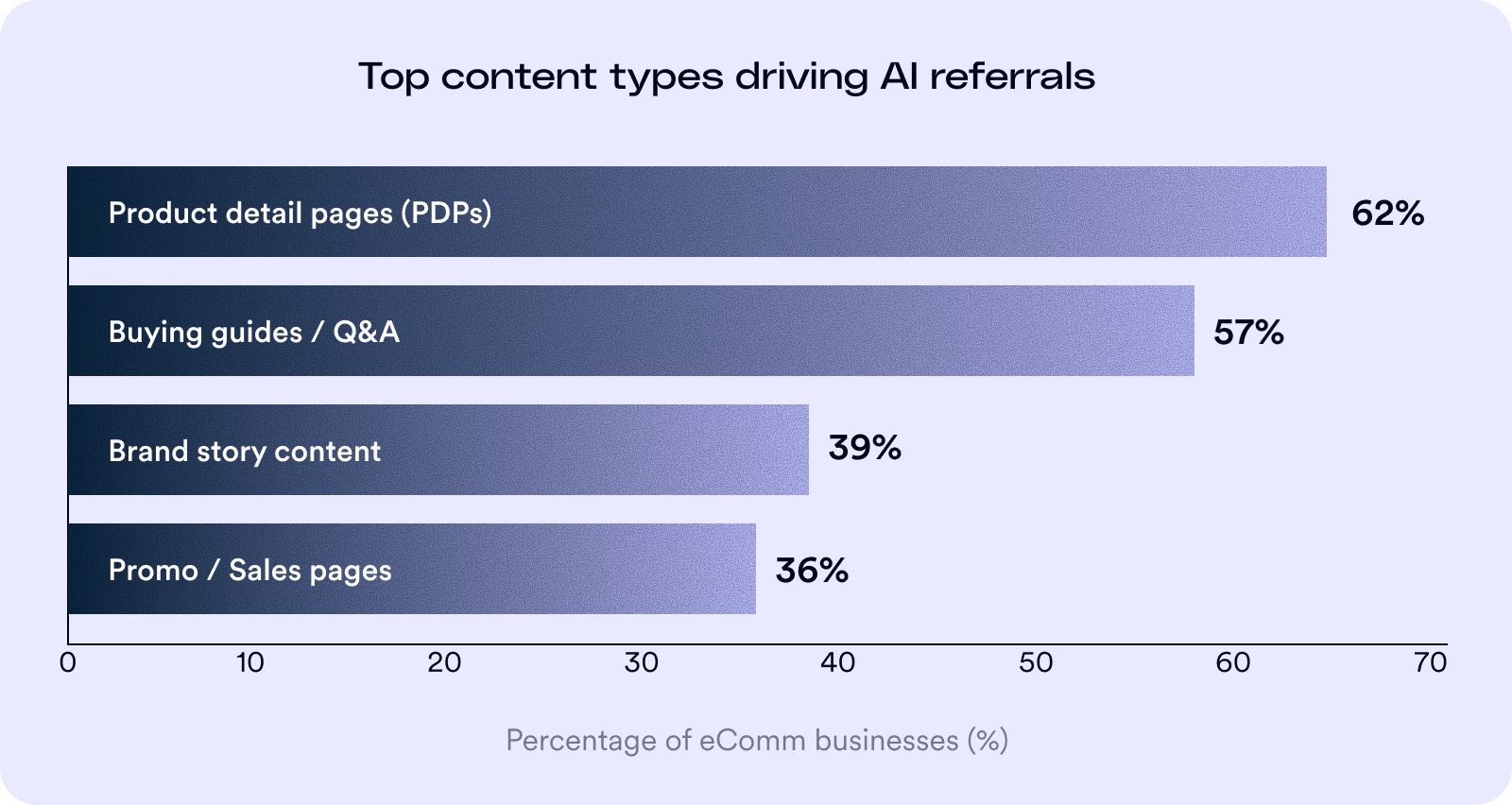About the research
Our eCommerce trends survey - conducted with Qualtrics, non-profit leaders, and disability community organizations - captured insights from over 300 eCommerce leaders and members of the disability community. The findings highlight how AI-driven discovery is reshaping online shopping, with retailers facing both a readiness gap and a clear opportunity: accessibility and structured data are the keys to visibility in the new era of conversational commerce.
Why AI chat search matters now
Online shopping no longer starts exclusively with a search bar. Increasingly, it begins with a question asked to an AI assistant: “What’s the best moisturizer for sensitive skin?” or “Find me a laptop under $1,000 that’s good for travel.” These assistants reply with synthesized recommendations, cutting through the noise and often embedding direct purchase links.
For eCommerce leaders, this new reality raises the stakes:
- AI assistants act as personal shoppers, guiding consumers directly to purchases without a website visit
- If your content isn’t optimized for AI chat search, your brand may never appear in results
- Early adopters are already gaining traffic and conversions from chatbot referrals that barely existed a year ago
Put simply, optimizing for AI discoverability requires the same foundation that accessibility demands. Structured product data, semantic markup, and alt text don’t just support screen readers — they also allow AI systems to correctly interpret and recommend your products.
The imperative is clear: brands must optimize for AI-driven discovery. The good news is that doing so creates a win-win: You gain visibility in the fast-growing commerce channel while ensuring that more customers, including those with disabilities, can successfully shop with you.
The same features that make a website accessible are what allow AI systems to recommend products in conversation |
From novelty to necessity
AI chat search has shifted from fringe experiment to mainstream channel. What was negligible referral traffic in the past has grown into billions of visits monthly.
- ChatGPT drives around 20% of referrals to Walmart
- Amazon’s Rufus AI, which integrates catalog data into conversational answers, is already driving millions of clicks
- Airbnb is developing GPT-powered agents to keep discovery and booking inside its ecosystem.
This shift reflects changing consumer expectations. People no longer want to scroll through pages of ads and results; they want quick, contextual answers they can act on immediately. And when assistants deliver that clarity, the old search experience feels outdated. In fact, our survey of 300 eComm leaders shows 74% are adjusting product content to be AI-chat-friendly, a sign businesses are preparing even if traffic is still small for them today.

This isn’t just anecdotal. The numbers show how fast consumer behavior is changing. Shoppers are turning to AI assistants for quick, contextual answers they can act on immediately. When the experience works, it doesn’t just complement traditional search; it replaces it.

It’s clear that AI chat search has crossed the threshold from curiosity to mainstream utility.
Inaccessible content is invisible content
But assistants don’t reward brand recognition; they reward data quality. The best-structured product wins, not necessarily the biggest name. That creates opportunity for nimble mid-market players but also risk: inaccessible content is invisible content. While a majority of eComm leaders are actively adjusting product content for AI discoverability, many overlook that accessibility practices are what can help make this content truly readable — both for people and for AI assistants.
Accessibility: The cornerstone AI discoverability
AI chat assistants and accessibility share the same foundation: clean, structured, inclusive data. If your PDPs, FAQs, or product feeds are poorly structured, you risk exclusion on two fronts. Survey results confirm this: PDFs and Q&A content - the most dependent on accessibility markup - are also the top drivers of AI referrals. Shoppers with disabilities can’t complete their journey, and AI assistants can’t parse your catalog.

The key takeaway: When brands get accessibility right, they unlock dual benefits: better customer experience and greater discoverability.
When brands get accessibility right, they unlock dual benefits: better customer experience and greater discoverability |
Benefits of accessible AI-ready content
- Visibility & SEO: Structured markup ensures AI assistants cite your products
- Conversion: Reliable data improves trust and purchase follow-through
- Brand equity: Inclusive content strengthens reputation across audiences
- Compliance: Reduces exposure to lawsuits and regulatory penalties
Risks of inaccessible content
- Invisibility: Products won’t appear in AI chat results
- Exclusion: Disabled shoppers face barriers in discovery or checkout
- Reputation loss: Failing to surface signals irrelevance in an AI-first market
Accessibility shouldn’t be an afterthought. It’s infrastructure for the AI era. Tools like accessFlow can help ensure catalogs are accessible, structured, and audit-ready, protecting compliance while maximizing visibility.
Maximizing the holiday season
Our research shows that 96% of eComm businesses are preparing to expose their product catalogs through plugins and apps — and 78% say AI referrals are critical to performance across key shopping periods.
But visibility alone isn’t enough. If catalogs aren’t structured accessibly, new plugins won’t broaden reach — they’ll narrow it. Accessibility is the difference between being listed and being chosen, between appearing in results and actually converting high-intent demand.
How eCommerce leaders can get ahead in AI chat search
- Design for discoverability
AI assistants promote what they can read, and that depends on structured, accessible content. Use headings, semantic markup, alt text, and rich product specifications so your catalog can be correctly parsed and surfaced in AI-generated answers. Without this, your products may not exist in the new AI-driven discovery landscape. - Audit both AI and accessibility performance
Don’t assume your content works just because it looks good on your site. Test how it appears in AI assistants and how it functions with screen readers and other assistive technologies. These two tests overlap significantly, and together they reveal the gaps that block visibility and usability. - Enrich product data
Go beyond basic descriptions. Add specifications, synonyms, FAQs, and contextual details that clarify your products for all users. This helps shoppers with disabilities understand your offerings while making it more likely that AI assistants recommend you over competitors. - Prepare for multi-channel AI commerce
AI-driven shopping will happen across many assistants — from ChatGPT and Gemini to retailer-owned platforms. Make sure your content is consistently accessible and structured across every channel where your products might appear, not just your own website. - Bring in real users
Internal QA won’t catch everything. Involve people with disabilities in testing your content and shopping flows. Their experiences highlight barriers that exclude both human shoppers and AI systems, ensuring your optimizations reflect real-world needs. - Treat accessibility as strategy, not compliance
Accessibility isn’t a box to tick after the fact, but the foundation that determines whether you show up in AI chat search at all. By embedding accessibility into your content strategy, you mitigate legal risks, expand your audience, and future-proof your business against the rapid evolution of AI-driven commerce.
Accessibility is the new visibility
AI chat search is redefining how shoppers discover and choose products, and the shift is happening faster than most brands realize. In this environment, accessibility isn’t just about compliance or inclusion — it’s the foundation of discoverability itself. Structured, inclusive content ensures your products are visible to AI systems and usable by every customer.
For eCommerce leaders, treating accessibility as core infrastructure for the AI era helps you gain visibility, trust, and conversions in the channels shaping the future of commerce.
AI chat search isn’t just changing how people shop — it’s changing who gets to be shopped. Accessibility is what puts your brand in the conversation.
Frequently asked questions about AI chat search & eCommerce accessibility
Q1. What is “AI chat search” and why does it matter for eCommerce?
A1. AI chat search refers to conversational AI systems that understand natural-language queries and return direct answers or product suggestions instead of traditional search-results pages. As more shoppers use AI assistants and chat-based discovery, visibility in these channels is becoming a core growth opportunity for eCommerce brands.
Q2. How does accessibility influence visibility in AI chat search?
A2. AI systems depend on clean, structured, and accessible content to understand and interpret information. When product data, images, descriptions, and navigation are accessible—using alt text, semantic markup, correct headings, and ARIA attributes—AI can reliably parse and surface your content. If your site is inaccessible, AI systems are less likely to reference your products.
Q3. How is shopper behavior changing in ways that affect search and discovery?
A3. Shoppers increasingly use voice assistants and conversational queries such as “best waterproof hiking boots for flat feet.” AI chat systems respond with curated product suggestions rather than long result lists. This shift means discoverability now depends on how well your data can be interpreted—not how well you perform in traditional keyword SEO.
Q4. How should eCommerce product data be optimized for AI chat search?
A4. Brands should use structured product data, descriptive alt text, semantic headings, accessible navigation, clear labeling, and consistent metadata. Accessible content makes your catalog easier for AI to parse and match with user queries.
Q5. Why is accessibility now a strategic business advantage—not just a compliance requirement?
A5. Because accessible content isn’t only easier for people with disabilities to use—it’s also easier for AI systems to understand. Accessibility ensures your products can be indexed, interpreted, and recommended by AI chat assistants. Inaccessible structures limit both usability and digital visibility.
Q6. What risks do brands face if they ignore accessibility in the AI-search era?
A6. Brands risk diminished visibility in AI-driven discovery channels, missed conversions, and legal exposure under laws like the ADA. They may also lose competitive ground to retailers whose product data is more readable, structured, and inclusive.
Q7. How can accessiBe help brands prepare for AI chat search while maintaining accessibility?
A7. accessiBe provides an ecosystem of tools that help eCommerce brands structure product data, identify accessibility barriers, remediate code issues, and maintain WCAG alignment. This supports discoverability in AI search environments while ensuring inclusive, usable shopping experiences for all customers.
Q8. What immediate steps should eCommerce brands take to prepare for AI chat search?
A8. Audit accessible structure across product pages, ensure alt text and semantic markup are in place, optimize product feeds, test voice/assistant interactions, and integrate accessibility into ongoing content and development workflows. Treat accessibility as a core component of AI-readiness, not an add-on.


